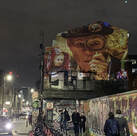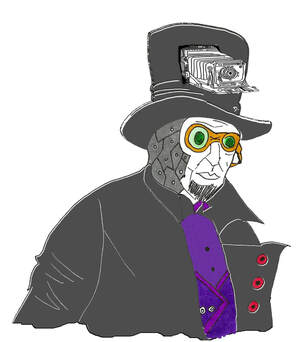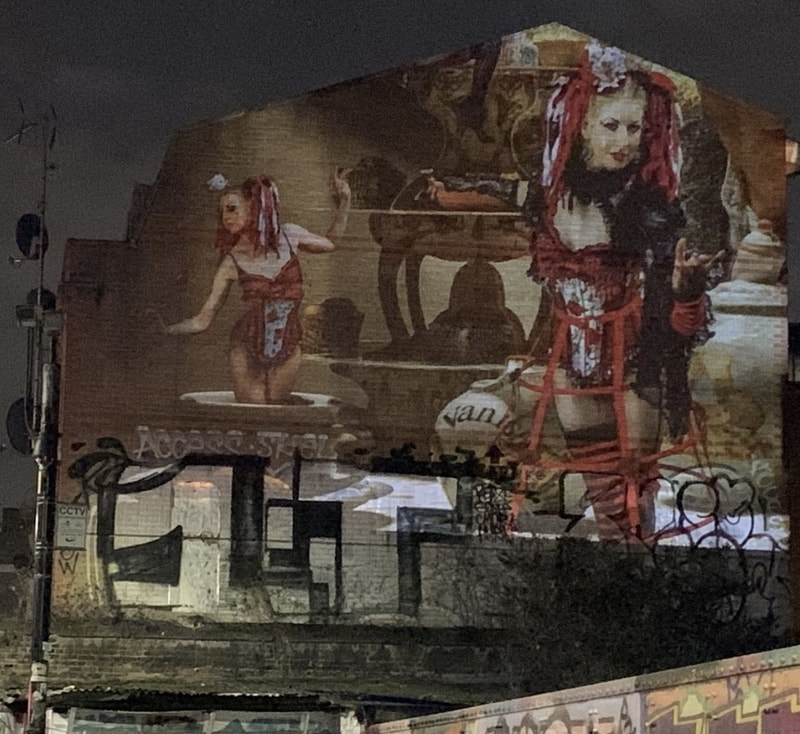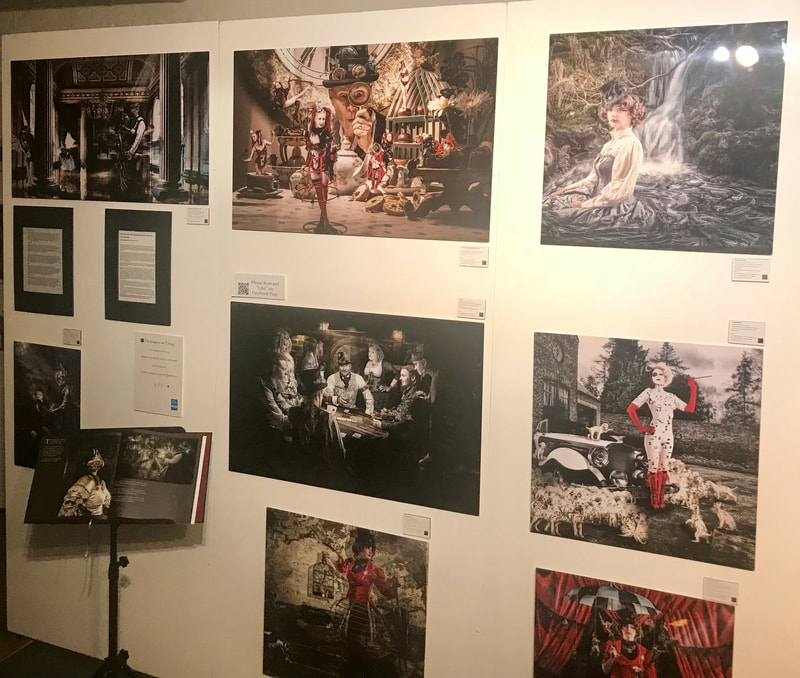
Gary Nicholls is a fine art photographic artist from Hertfordshire, England.
His camera is his tool of choice for his creations, all printed on aluminium.
His work is composed of multi-layered images using places, objects and people he has photographed, telling a sequential art story, which takes his audience on a journey into his own imagination.
Gary has been a member of The Cult House since May 2017. He was a finalist for It’s Art Call 2018, exhibited at Fusion V in March 2019.
Could you tell us a little about your background?
I was born in Essex. I studied Design Technology and Technical Drawing at Shoreditch College. During my studies, I also took Art classes, which is when I realised that I have a natural eye for seeing completed images in my mind.
I discovered Steampunk in 2012, and that is when I started working as an artist using photography as a medium.
In 2016, I published Book One of The Imaginarium Trilogy, a 450-image story that has so far taken 6 years to complete.
I am currently working on Book Two, scheduled to be published in November 2019.
Who have been the biggest influences for you as an artist?
The first was my father. He was a member of a Photographic Society that had Alfred Hitchcock as the president. He influenced the way my father looked at lighting. As a young child, I was taught how to take pictures, for example, using only candlelight. But the most important factor was related to how my father got me to understand my inbuilt natural style. Tearing out pictures from magazines that I liked, writing what I liked about each one around them, and as a result, the elements that kept cropping up from my selections, like composition, landscape, colour tone, black and white, portraits etc. determined what my natural eye was tuned to. He also taught me to draw and paint which is a great advantage when I use a tablet with Photoshop as my eye-hand co-ordination is not an issue.
I was also very inspired by artists such as Caravaggio, Dali and Vermeer. I am a technical artist, hence my love of the old masters and their techniques.
The way that Caravaggio and Vermeer are able to focus the viewer on the subject of their art by the use of light changed the way I work.
Photoshop is about layers, and I use those layers to create a luminosity that only comes alive when printed on metal, meaning the print medium is an important part of the process. Caravaggio and Vermeer never had backgrounds that were blurred, meaning that one looks at the subject because of the lighting. I replicate that look, but with a camera and lights.
Their art tells a story as does mine, and creating a particular mood with light sells the story of the image to the viewer. I am an artist with a camera, not a photographer.
His camera is his tool of choice for his creations, all printed on aluminium.
His work is composed of multi-layered images using places, objects and people he has photographed, telling a sequential art story, which takes his audience on a journey into his own imagination.
Gary has been a member of The Cult House since May 2017. He was a finalist for It’s Art Call 2018, exhibited at Fusion V in March 2019.
Could you tell us a little about your background?
I was born in Essex. I studied Design Technology and Technical Drawing at Shoreditch College. During my studies, I also took Art classes, which is when I realised that I have a natural eye for seeing completed images in my mind.
I discovered Steampunk in 2012, and that is when I started working as an artist using photography as a medium.
In 2016, I published Book One of The Imaginarium Trilogy, a 450-image story that has so far taken 6 years to complete.
I am currently working on Book Two, scheduled to be published in November 2019.
Who have been the biggest influences for you as an artist?
The first was my father. He was a member of a Photographic Society that had Alfred Hitchcock as the president. He influenced the way my father looked at lighting. As a young child, I was taught how to take pictures, for example, using only candlelight. But the most important factor was related to how my father got me to understand my inbuilt natural style. Tearing out pictures from magazines that I liked, writing what I liked about each one around them, and as a result, the elements that kept cropping up from my selections, like composition, landscape, colour tone, black and white, portraits etc. determined what my natural eye was tuned to. He also taught me to draw and paint which is a great advantage when I use a tablet with Photoshop as my eye-hand co-ordination is not an issue.
I was also very inspired by artists such as Caravaggio, Dali and Vermeer. I am a technical artist, hence my love of the old masters and their techniques.
The way that Caravaggio and Vermeer are able to focus the viewer on the subject of their art by the use of light changed the way I work.
Photoshop is about layers, and I use those layers to create a luminosity that only comes alive when printed on metal, meaning the print medium is an important part of the process. Caravaggio and Vermeer never had backgrounds that were blurred, meaning that one looks at the subject because of the lighting. I replicate that look, but with a camera and lights.
Their art tells a story as does mine, and creating a particular mood with light sells the story of the image to the viewer. I am an artist with a camera, not a photographer.
How did your Imaginarium Trilogy concept come about, and how has the project evolved since you first started working on it?
I wanted to create a small series of images that tell a story.
A visit to The Lincoln Steampunk Festival meant that I realised I had found a theme for that short story. Little did I know that it would become a 450-image trilogy involving over 150 Steampunks and sold worldwide! I wanted to do this because it has not been done since Hogarth and I wanted to create a different sort of fine art book.
The first book of 150 prints was completed after 4 years work.
I am currently working on the second volume, The Imaginarium - Robbie Pertwee, which will be coming out later this year, after 3 years work.
The whole trilogy is about a secret in a box, with a time travelling serial killer in the second book, killing some of the people that had the box in the first volume. I am also working on a series of pictures called The Human Zoo: complex images of women who have the skin of the animals in the image.
The first time I saw your work, I felt like I was stepping into another world, a bit like following the White Rabbit in Alice in Wonderland. How do people react to your work?
The general feeling is one of disbelief with regards to my imagination.
People feel they are being taken into a world that is fantasy, but completely believable. Some of the images have a semi-erotic romantic look, and this seems to appeal to followers of my work. Some viewers have remarked that they have found themselves feeling they are ‘home’ in my work. Others feel that my work is the ‘Harry Potter’ of the art world, making them feel totally submerged into the world I have created.
Another feeling is one of curiosity. People always stare for a long time and always see new things. I think they are intrigued and keen to know more about the messages in the pictures that can create a feeling of being transported to another place and time.
Lastly, I think people also feel inspired to go away and create something totally unique.
Once, a student approached me and told me that after seeing my work online, she felt she had to come and see me at an exhibition because my work had inspired her to take a photography course at Nottingham University. She had never seen my work in real life or spoken to me. That meant more to me that selling my art or books.
Be inspired and go and do, the worst that can happen is you learn something.
Have any of your viewer’s observations inspired you to go in a particular direction with your work?
It has not necessarily been about observations, but mostly generated from the costume a Steampunk has created.
When I see them, an entire character forms in my mind. I know the complete backstory.
I then approach them and ask if they would like to be featured in my art, playing the character I have just ‘seen’.
I am a storyteller, therefore that story has to be evident in my work.
My ideas also come from talking to people and listening to their experiences. A buyer of my work is currently researching her PhD in parapsychology, and relayed a story to me about a street in Liverpool being a time-slip. This gave me the idea of a time tunnel for the second volume of The Imaginarium. The one thing you must always be aware of is continuity, as there will always be a viewer that spots something that is out of place!
I wanted to create a small series of images that tell a story.
A visit to The Lincoln Steampunk Festival meant that I realised I had found a theme for that short story. Little did I know that it would become a 450-image trilogy involving over 150 Steampunks and sold worldwide! I wanted to do this because it has not been done since Hogarth and I wanted to create a different sort of fine art book.
The first book of 150 prints was completed after 4 years work.
I am currently working on the second volume, The Imaginarium - Robbie Pertwee, which will be coming out later this year, after 3 years work.
The whole trilogy is about a secret in a box, with a time travelling serial killer in the second book, killing some of the people that had the box in the first volume. I am also working on a series of pictures called The Human Zoo: complex images of women who have the skin of the animals in the image.
The first time I saw your work, I felt like I was stepping into another world, a bit like following the White Rabbit in Alice in Wonderland. How do people react to your work?
The general feeling is one of disbelief with regards to my imagination.
People feel they are being taken into a world that is fantasy, but completely believable. Some of the images have a semi-erotic romantic look, and this seems to appeal to followers of my work. Some viewers have remarked that they have found themselves feeling they are ‘home’ in my work. Others feel that my work is the ‘Harry Potter’ of the art world, making them feel totally submerged into the world I have created.
Another feeling is one of curiosity. People always stare for a long time and always see new things. I think they are intrigued and keen to know more about the messages in the pictures that can create a feeling of being transported to another place and time.
Lastly, I think people also feel inspired to go away and create something totally unique.
Once, a student approached me and told me that after seeing my work online, she felt she had to come and see me at an exhibition because my work had inspired her to take a photography course at Nottingham University. She had never seen my work in real life or spoken to me. That meant more to me that selling my art or books.
Be inspired and go and do, the worst that can happen is you learn something.
Have any of your viewer’s observations inspired you to go in a particular direction with your work?
It has not necessarily been about observations, but mostly generated from the costume a Steampunk has created.
When I see them, an entire character forms in my mind. I know the complete backstory.
I then approach them and ask if they would like to be featured in my art, playing the character I have just ‘seen’.
I am a storyteller, therefore that story has to be evident in my work.
My ideas also come from talking to people and listening to their experiences. A buyer of my work is currently researching her PhD in parapsychology, and relayed a story to me about a street in Liverpool being a time-slip. This gave me the idea of a time tunnel for the second volume of The Imaginarium. The one thing you must always be aware of is continuity, as there will always be a viewer that spots something that is out of place!
Gary’s work can be found here: http://www.theculthouse.co.uk/gary-nicholls.html.
He will be exhibiting at the Sussex Art Fair, on 18th and 19th of May 2019.
Gary’s Imaginarium Book 1 – Eva’s Story is available for purchase at the fair and on his website: https://www. imaginariumtrilogy.co.uk/
Check it out also Gary Instagram page here.
He will be exhibiting at the Sussex Art Fair, on 18th and 19th of May 2019.
Gary’s Imaginarium Book 1 – Eva’s Story is available for purchase at the fair and on his website: https://www. imaginariumtrilogy.co.uk/
Check it out also Gary Instagram page here.
Illustration by: Dominique Marchi









